If you add peeled and deveined shrimp to your culinary repertoire, then you can heighten the appreciation others have for your seafood cooking. When done right, you'll look like a master with your Seido Shears and Kitchen Scissors before you delight and entertain guests and family alike with your refined recipes. Learn how to peel and devein shrimp step by step, and everyone will eat well when it's your turn to cook.
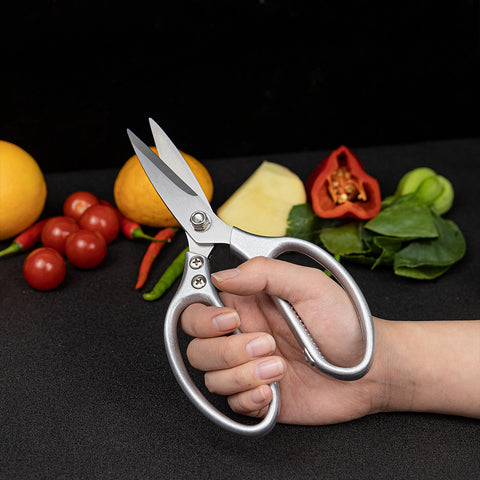
Explore Our Finest Selection of Kitchen Shears for Butterflying Shrimp →
TOOLS NEEDED
Butterflying shrimp involves manual labor, but you need more than your hands. Specific materials include a paring knife, a cutting board, a bowl of cold water, and paper towels.
PARING KNIFE
Whether you own the Hanikamu VG10 Damascus Chef Knife Set or the Tengoku Chef Knife Set, 10-Piece, make sure your collection has a paring knife included. A chef's knife is great for hard vegetables, but a paring knife is like a mini version useful for mincing onions, peeling potatoes, or coring tomatoes. They're typically less than 8 inches in length, and they give you precision control over ingredients with odd shapes. That's why they're so useful when it's time to learn how to peel shrimp.
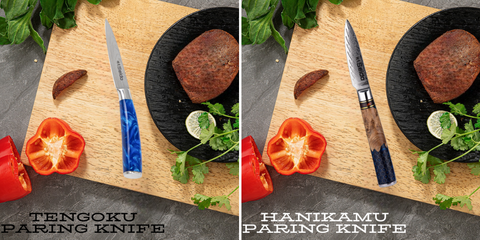
CUTTING BOARD
Learning how to butterfly shrimp is easier when you have a stable surface you can rely on, and the Gourmet Acacia, End Grain Cutting Board is an effective option. The stability helps you avoid injuries or wasting ingredients. Make sure you use a dedicated cutting board for seafood, poultry, and meat and a different one for ready-to-eat items. This prevents cross-contamination from uncooked foods.
BOWL OF COLD WATER
If you have frozen shrimp that you need to thaw, put them in a sealed plastic bag to keep water out. Then, submerge the bag in cold water. Change the water every half an hour to keep it cold. A bowl of cold water is also necessary for cleaning shrimp.
PAPER TOWELS
When you are done deveining shrimp in the steps listed below, you'll need a place to put them. Lay them on paper towels to absorb any extra moisture. Use a second paper towel to pat them dry, but do so gently. You'll get more even cooking with dry shrimp.
Learn How to Butterfly Shrimp Like a Pro With Seido Knives!
STEPS TO PEEL, DEVEIN, AND BUTTERFLY SHRIMP
The process is, fortunately, simple, and it's also quite useful. A cut shrimp has more surface area for searing or seasoning, so your finished dish can have much more flavor. Smaller shrimp cuts might even stretch your grocery dollars further.
1. PEEL
Peel off the hard outer shell from each shrimp using your hands, but leave the tail intact. The easiest starting point is the innermost concave curve. Depending on what level of processing the shrimp have been through, that's either where the legs were or still are.
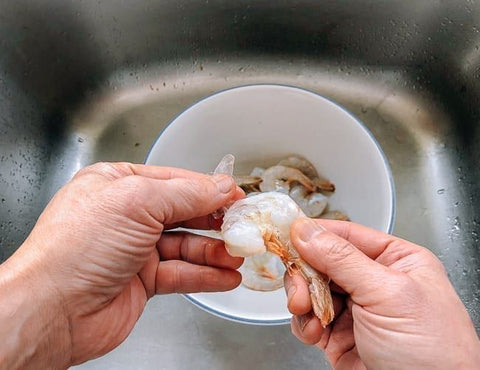
2. DEVEIN
With a sharp knife, make a three-quarters cut into the shrimp, starting from the head and moving down to the tail. The two halves should remain connected. Use the knife tip to remove the dark vein along the shrimp's back. Throw the vein away.
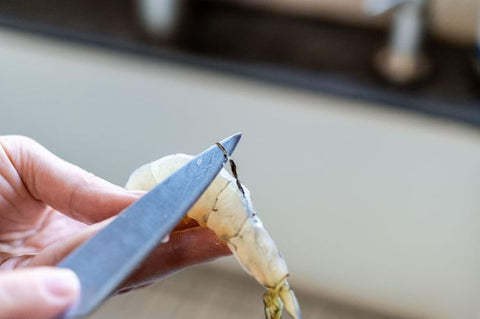
3. BUTTERFLY
Open the shrimp up like a book without splitting it into different pieces. Once the butterflied shrimp is flat, you can serve or cook them.
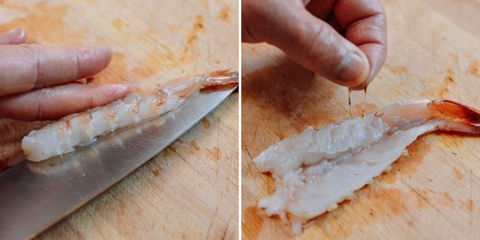
PRO TIPS
- If you don’t have time for cold water thawing, use your microwave on a lower-power or defrost setting.
- Don’t refreeze thawed shrimp if you want to maintain the quality.
- Avoid using hot water or room-temperature conditions to thaw shrimp so you can prevent bacterial growth.
- Shrimp prepared in a butterfly style are versatile and can be sautéed, steamed, stir-fried, or grilled.
FAQ
Q: Should shrimp be peeled and deveined before or after they get boiled?
A: It’s better to peel and devein the shrimp before boiling so that flavors can get further into the meat during cooking.
Q: Do unpeeled shrimp need deveining?
A: Yes. Removing the vein pulls out a shrimp’s digestive tract. It’s edible, but it detracts from the taste and texture.
Q: Should both sides be deveined?
A: Only the back needs it.
Final Thoughts
Shrimp has a minimal cooking time. Investing extra moments into food prep means your final dish has more flavor. You'll also get more bang for your buck with your food shopping by making the most of your ingredients.



